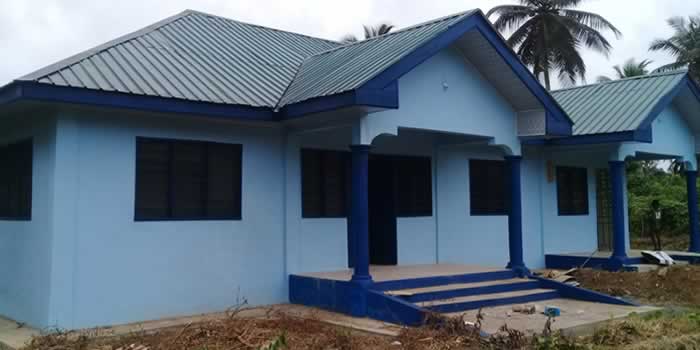

Jomoro Municipal is basically an agricultural one and arable farming and livestock rearing constitute the backbone of her economy. Agriculture engages about 65-70% of the population who obtain their livelihood in farming and other agric related activities such as deep sea and fresh water fishing as well as coconut oil extraction.
The district is amply endowed with excellent climatic conditions, vegetation, streams and rivers, soil rich in nutrient capable of supporting various types of crop production. Refer to tables 31, 32, 33, 34, in pdf file below.
Limited Access To Farming Lands
Thirty percent (30%) of land in the district is taken over by the Ankasa Forest Reserve and the rest distributed as below;
In 2005, fallow lands decreased from 3% to 1% due to increase in population which placed more pressure on land for settlement and farming. The only option is to promote interventions that will increase yield per acre on existing land.
The increase in acreage for food crops in 2005 could mean an increase in the qualities produced and when managed effectively can lead to increase in yield per acre without more increase in acreage under cultivation.
Cassava and maize are the main food crops cultivated in the district. Mixed cropping enables the farmer to get more from the same plot of land, thus increasing his family income.
Coconut cropping stagnated due to the fear of the Cape St. Paul Wilt Disease. Currently there is a programme in place to replant all the plantations with the hybrid disease tolerant variety. The coconut intensification programme where NPK and Ammonia Fertilizers were applied to some selected plantation to increase yield per tree/year from a low of 120 nut/tree/year to an average of 200 nuts/tree/year i.e. 100-150% increase.
The decline in the production of coffee and citrus was due to the high interest shown for cocoa and oil palm cultivation which is enjoying a lot of support from Government.
Small ruminants abound in the district but farmers do not give them the attention needed even though their prices are good.
Pigs are reared more intensively by the youth who see it as a means to help them raise money for other ventures. Coconut chaff, a by-product from the oil extraction, forms the main feed ingredient. Poultry production is also gaining ground in the district and needs to be promoted.
Scarcity Of Quality Planting Materials/Breeding Stock
Access to disease free planting materials during planting season in very difficulty due to the absence of certified seeds and other agro input dealers locally. Where available the prices on offer are so high that most farmers cannot afford and these resort to the use of sub-standard and diseased planting materials for planting with the attendant low yields per acre and reduction in income. MOFA – DADU has been organizing training and demonstrations to teach farmers on how to select, prepare and manage good planting materials so as to derive maximum returns from them.
Absence Of Small Scale Irrigation System/Facilities;
In spite of the abundant water bodies available, there is no irrigation system of any kind for all year round cropping. Thus most farmers rely heavily on natural rains for production. There is urgent need for some irrigation systems which will support dry season vegetable farming where the district stands to gain a lot of benefits.
High Post Harvest Losses
The humid nature of the climate coupled with incessant rains make drying and storage of farm produce very difficult. Stored grains become mouldy and vegetables get rotten.
Simple on farm tools, for drying of produce to enable them stay longer in the barns, on-farm processing of farm produce should be encouraged to reduce losses and add value, thus giving the farmers more income.
Over the years credit facilities given to some farming groups, though not sufficient, enabled them to process some of the cassava into gari for the market thus reducing losses that could have occurred had the excess being left to rot on the farms. It is suggested that, cottage industries for processing of Agro-products should be encouraged to add value to farm produce.
Inaccessible Farm Roads
The network of farm roads, tracks and trails are so bad that most farm produce cannot be carted to the marketing centre on time for sale, thus burdening the farmer and reducing his income.
Rehabilitation of feeder roads would encourage the farmer to produce more, thereby getting the needed income from his activities. Small farm machinery like power tillers, bicycle with trailers when sold to farmers on credit bases would relieve farmers of the drudgery they go through in carrying farm produce.
Low Extension Agent To Farmer Ratios
The present scenario is that one (1) extension agent serves about 4000 farmers. This situation is not acceptable with the present vision of modernizing agriculture. There is therefore the need to recruit enough agents to carry out extension packages to the farmers for adoption.
Major Occupation
Agribusiness is the mainstay of the district economy, employing about 90% of the working population.
Major Plantation Crops
Coconut, cocoa, oil palm and rubber
Major Food Crops
Cassava, plantain, rice, maize, cocoyam and vegetables.
Potential Exportable Crops
Ginger, black pepper and sunflower. These crops are being promoted.
Potential areas for Agricultural Investment:Pig production, fish farming, ginger cultivation and coconut cultivation.
Fishing
About 3,500 people are engaged in fishing and its related activities with 199 registered canoes. Lack of storage facilities and credit to purchase inputs are the major constraints faced by the fishermen. The main landing beaches are Half Assini, Ahobre, and Effasu.
Date Created : 11/20/2017 5:06:42 AM









 facebook
facebook
 twitter
twitter
 Youtube
Youtube
 +233 593 831 280
+233 593 831 280 0800 430 430
0800 430 430 GPS: GE-231-4383
GPS: GE-231-4383 info@ghanadistricts.com
info@ghanadistricts.com Box GP1044, Accra, Ghana
Box GP1044, Accra, Ghana